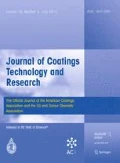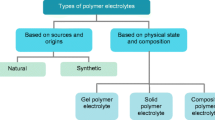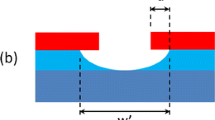Abstract
In the field of organic and printed electronics (e.g., polymer solar cells, OLEDs, or Li-ion batteries), there is a growing demand for thin functional layers with highly homogeneous surface topology. If these layers are coated from the liquid phase, the coating and drying steps affect the surface quality. As a result of inhomogeneous drying rates, the solvent concentration can vary along the top surface and the thickness of a solidifying solution, leading to local differences in surface tension. In turn, Marangoni convection, as the balancing mechanism, can occur and cause surface inhomogeneity. The in situ reconstruction of the free surface during drying has been presented elsewhere. During this investigation phenomena occurred that could not be completely understood without knowledge of the respective flow field. In the present work, the visualization of the flow field in thin polymer films [methanol-poly(vinyl acetate) solution with 67 wt% methanol] due to inhomogeneous drying is presented. To resolve the flow field, we apply fluorescent particle tracking (µPTV). Since both measurement techniques cannot easily be applied at the same time, the boundary conditions were adapted to the way of observation of each experimental setup. In the case of the setup for surface reconstruction of the free surface, locally different evaporation rates were realized by drying on a structured substrate (varying material). To force similar variation of the drying conditions in the case of the µPTV setup, the drying film was partially covered. As expected, both boundary conditions result in a propagating wave front towards regions of high surface tension. Combining both experimental setups, we were able to visualize the free surface and the flow structures up- and downstream of the wave front and found different flow regimes.












Similar content being viewed by others
References
Moule, AJ, Bonekamp, JB, Meerholz, K, “The Effect of Active Layer Thickness and Composition on the Performance of Bulk-Heterojunction Solar Cells.” J. Appl. Phys., 100 (9) 094503 (2006)
Kirchartz, T, et al., “Understanding the Thickness-Dependent Performance of Organic Bulk Heterojunction Solar Cells: The Influence of Mobility, Lifetime, and Space Charge.” J. Phys. Chem. Lett., 3 (23) 3470–3475 (2012)
Vieyra Salas, JA, et al., “Active Control of Evaporative Solution Deposition by Modulated Infrared Illumination.” J. Phys. Chem C, 116 (22) 12038–12047 (2012)
Cavadini, P, et al., “Investigation of Surface Deformation During Drying of Thin Polymer Films Due to Marangoni Convection.” Chem. Eng. Process. Process. Intensif., 64 24–30 (2013)
Levich, VG, Krylov, VS, “Surface Tension Driven Phenomena.” Annu. Rev. Fluid Mech., 1 293–316 (1969)
Harris, DJ, Lewis, JA, “Marangoni Effects on Evaporative Lithographic Patterning of Colloidal Films.” Langmuir, 24 (8) 3681–3685 (2008)
Harris, DJ, et al., “Patterning Colloidal Films via Evaporative Lithography.” Phys. Rev. Lett., 98 (14) 148301 (2007)
Park, JS, Kihm, KD, “Three-Dimensional Micro-PTV Using Deconvolution Microscopy.” Exp. Fluids, 40 (3) 491–499 (2006)
Griebel, M, et al., Numerische Simulation in der Moleküldynamik: Numerik, Algorithmen, Parallelisierung, Anwendungen, p. 480. Springer, Berlin (2004)
Santiago, JG, et al., “A Particle Image Velocimetry System for Microfluidics.” Exp. Fluids, 25 (4) 316–319 (1998)
Inoué, S, Spring, KR, Video Microscopy: The Fundamentals. Plenum Press, New York (1997)
Frisken Gibson, S, Lanni, F, “Experimental Test of an Analytical Model of Aberration in an Oil-Immersion Objective Lens Used in Three-Dimensional Light Microscopy.” J. Opt. Soc. Am. A, 9 (1) 154–166 (1992)
Park, JS, Choi, CK, Kihm, KD, “Temperature Measurement for a Nanoparticle Suspension by Detecting the Brownian Motion Using Optical Serial Sectioning Microscopy (OSSM).” Meas. Sci. Technol., 16 (7) 1418 (2005)
Speidel, M, Joná, A, Florin, E-L, “Three-Dimensional Tracking of Fluorescent Nanoparticles with Subnanometer Precision by Use of Off-Focus Imaging.” Opt. Lett., 28 (2) 69–71 (2003)
Wu, M, Roberts, JW, Buckley, M, “Three-Dimensional Fluorescent Particle Tracking at Micron-Scale Using a Single Camera.” Exp. Fluids, 38 (4) 461–465 (2005)
Schabel, W, Trocknung von Polymerfilmen-Messung von Konzentrationsprofilen mit der Inversen-Mikro-Raman-Spektroskopie, in Institut für Thermische Verfahrenstechnik. Universität Karlsruhe (TH), Karlsruhe (2004)
Author information
Authors and Affiliations
Corresponding author
Rights and permissions
About this article
Cite this article
Cavadini, P., Erz, J., Sachsenheimer, D. et al. Investigation of the flow field in thin polymer films due to inhomogeneous drying. J Coat Technol Res 12, 921–926 (2015). https://doi.org/10.1007/s11998-015-9725-9
Published:
Issue Date:
DOI: https://doi.org/10.1007/s11998-015-9725-9




